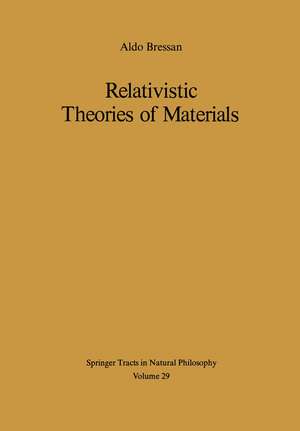Relativistic Theories of Materials: Springer Tracts in Natural Philosophy, cartea 29
Autor A. Bressanen Limba Engleză Paperback – 8 dec 2011
Din seria Springer Tracts in Natural Philosophy
-
 Preț: 378.92 lei
Preț: 378.92 lei -
 Preț: 389.88 lei
Preț: 389.88 lei -
 Preț: 376.22 lei
Preț: 376.22 lei -
 Preț: 489.59 lei
Preț: 489.59 lei -
 Preț: 383.33 lei
Preț: 383.33 lei -
 Preț: 386.61 lei
Preț: 386.61 lei -
 Preț: 386.00 lei
Preț: 386.00 lei -
 Preț: 383.33 lei
Preț: 383.33 lei -
 Preț: 378.34 lei
Preț: 378.34 lei -
 Preț: 380.63 lei
Preț: 380.63 lei -
 Preț: 379.48 lei
Preț: 379.48 lei -
 Preț: 382.57 lei
Preț: 382.57 lei -
 Preț: 377.57 lei
Preț: 377.57 lei -
 Preț: 379.86 lei
Preț: 379.86 lei -
 Preț: 393.74 lei
Preț: 393.74 lei -
 Preț: 376.04 lei
Preț: 376.04 lei -
 Preț: 486.16 lei
Preț: 486.16 lei -
 Preț: 356.38 lei
Preț: 356.38 lei - 20%
 Preț: 562.40 lei
Preț: 562.40 lei -
 Preț: 390.63 lei
Preț: 390.63 lei -
 Preț: 453.78 lei
Preț: 453.78 lei -
 Preț: 422.31 lei
Preț: 422.31 lei - 15%
 Preț: 630.43 lei
Preț: 630.43 lei -
 Preț: 383.12 lei
Preț: 383.12 lei - 15%
 Preț: 575.41 lei
Preț: 575.41 lei -
 Preț: 377.57 lei
Preț: 377.57 lei -
 Preț: 382.57 lei
Preț: 382.57 lei -
 Preț: 379.86 lei
Preț: 379.86 lei - 15%
 Preț: 631.21 lei
Preț: 631.21 lei - 15%
 Preț: 634.32 lei
Preț: 634.32 lei - 15%
 Preț: 637.78 lei
Preț: 637.78 lei - 18%
 Preț: 786.84 lei
Preț: 786.84 lei -
 Preț: 391.99 lei
Preț: 391.99 lei -
 Preț: 348.98 lei
Preț: 348.98 lei -
 Preț: 386.22 lei
Preț: 386.22 lei -
 Preț: 379.48 lei
Preț: 379.48 lei -
 Preț: 378.54 lei
Preț: 378.54 lei - 15%
 Preț: 647.59 lei
Preț: 647.59 lei -
 Preț: 378.12 lei
Preț: 378.12 lei
Preț: 391.61 lei
Nou
Puncte Express: 587
Preț estimativ în valută:
74.93€ • 78.45$ • 62.00£
74.93€ • 78.45$ • 62.00£
Carte tipărită la comandă
Livrare economică 08-22 aprilie
Preluare comenzi: 021 569.72.76
Specificații
ISBN-13: 9783642811227
ISBN-10: 3642811221
Pagini: 312
Ilustrații: XIV, 290 p.
Dimensiuni: 170 x 244 x 16 mm
Greutate: 0.5 kg
Ediția:Softcover reprint of the original 1st ed. 1978
Editura: Springer Berlin, Heidelberg
Colecția Springer
Seria Springer Tracts in Natural Philosophy
Locul publicării:Berlin, Heidelberg, Germany
ISBN-10: 3642811221
Pagini: 312
Ilustrații: XIV, 290 p.
Dimensiuni: 170 x 244 x 16 mm
Greutate: 0.5 kg
Ediția:Softcover reprint of the original 1st ed. 1978
Editura: Springer Berlin, Heidelberg
Colecția Springer
Seria Springer Tracts in Natural Philosophy
Locul publicării:Berlin, Heidelberg, Germany
Public țintă
ResearchCuprins
1. Introduction.- § 1. On the Beginning of Relativity.- § 2. The Space-Time Structure of Special Relativity and First Basic Consequences.- § 3. On the Operational Aspect of Physical Concepts.- § 4. New Ideas on Mass and Energy, in Contrast with Classical Physics, Accepted on the Basis of Special Relativity Kinematics.- § 5. On Forces, Cauchy Equations of Continuous Media, and the First Principle of Thermodynamics in Special Relativity.- § 6. On Electromagnetism, Heat Conduction, and Constitutive Equations in Special Relativity.- § 7. Gravitation and Relativity.- § 8. On the Local Equivalence Principle and the Basic Local Laws of the Electromagnetic Field and Continuous Media, Other than the Poisson Equation, in General Relativity. A Criterion Connecting those Laws with Their Analogues in Classical Physics or Special Relativity.- § 9. On the Invariance of Physical Equations and on the Possible Physical Equivalence of the Frames in which these Equations have the Same Form. On a Privileged Absolute Concept of Event Point.- § 10. On Harmonic Coordinates and the Existence of General Frames not Physically Equivalent in General Relativity.- § 11. Some Distinctive Properties of General Relativity. On the Equivalence of General Frames in General Relativity.- § 12. What We Mean by General Theory of Relativity.- § 13. On the Development of General Relativity. Inclusion of Elasticity, Electromagnitostriction, Couple Stresses, and Hereditary Phenomena.- § 14. Scope and Plan of the Present Tract.- Footnotes to Chapter 1.- I. Basic Equations of Gravitation, Thermodynamics and Electromagnetism, and Constitutive Equations from the Eulerian Point of View.- 2. Space-Time Kinematics Including Masses.- 3. Gravitation and Conservation Equations. Fluids and Elastic Waves.- 4.Electromagnetism from the Eulerian Point of View. Polarizable Fluids.- 5. On Media Capable of Electromagnetic Phenomena from the Eulerian Point of View. Magneto-Elastic Waves in Ideal Conductors.- II. Materials from the Lagrangian Point of View.- 6. Kinematics and Stresses from the Lagrangian Point of View.- 7. Elasticity, Acceleration Waves, and Variational Principles for Simple Materials.- 8. Piezo-Elasticity and Magnetoelastic Waves from the Lagrangian Point of View.- 9. Materials with Memory and Axiomatic Foundations.- 10. Couple Stresses and More General Stresses.- Appendix A. Double Tensors.- §A1. Definition of Double Tensors Related to Two Topological Spaces.- §A2. Partial Covariant Derivative and Total Covariant Derivative Based on a Mapping.- §A3. On Differentiation of Double Tensors, Functions of Double Tensors.- Case of Arguments Fulfilling Typical Regular Conditions.- Appendix C. On the Divergence of Spatial Vectors in Space-Time.- References.
















